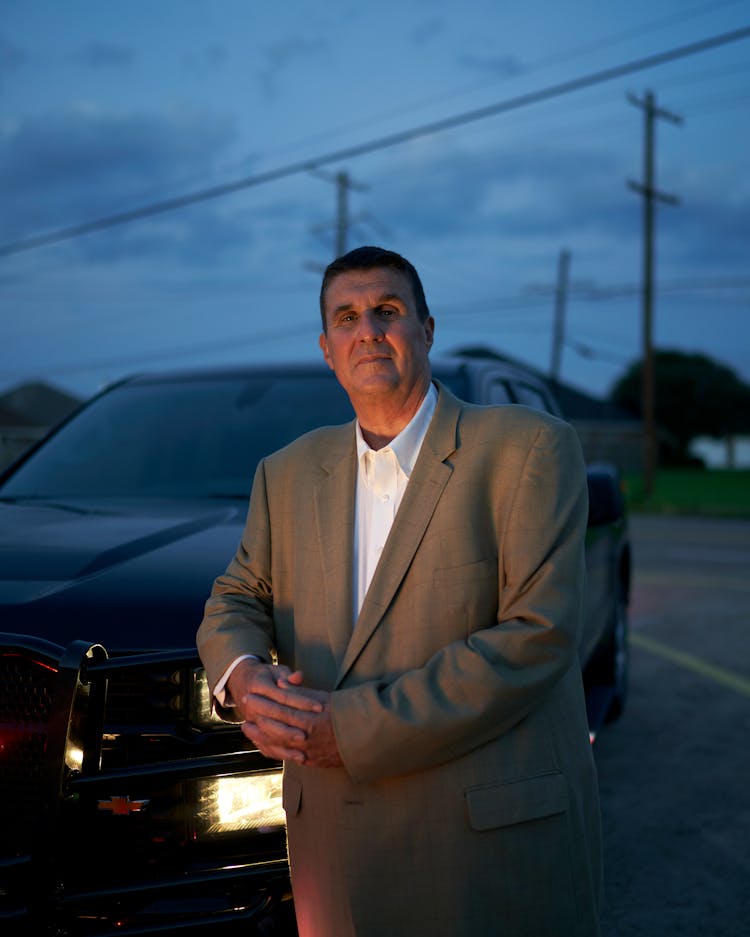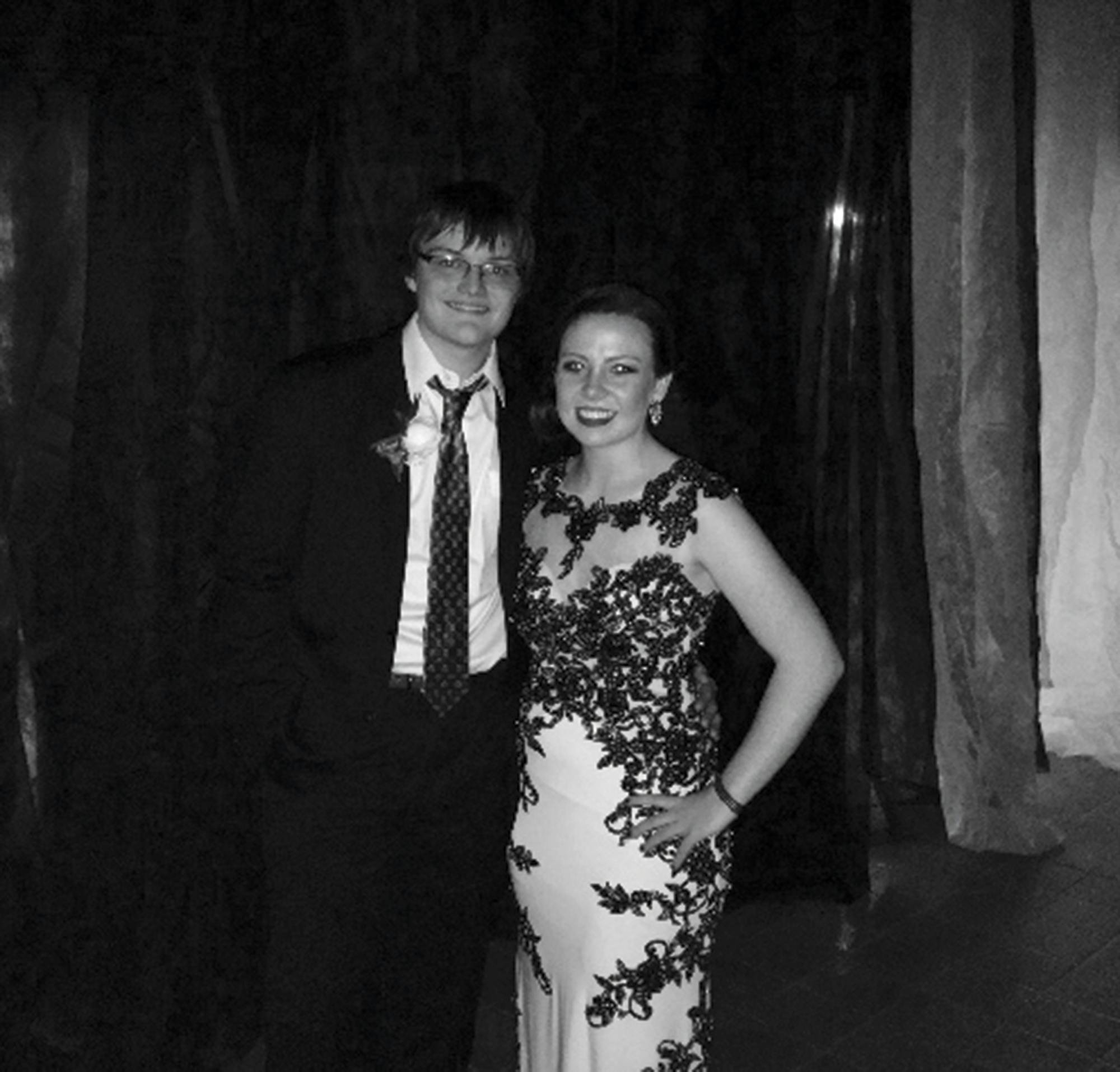Subscribe
“So, let’s go to the beginning of the Thomas Brown case,” Philip Klein told me when I went to see him at his office in Nederland, east of Houston. The private investigator leaned back in his leather chair. “It’s a hell of a case. And I can tell you a hundred of these cases that we’ve done that you would go, Oh, my God. ”
The 61-year-old Klein is a big guy, six feet six inches tall and 230 pounds, with an outsized personality to match. He’s cocksure, with a penchant for drama. In 2009 the NBC show Dateline shadowed Klein as he traveled to Mexico in hopes of tracking down Olivia Newton-John’s missing boyfriend, who had allegedly faked his own drowning. In the broadcast, Dateline correspondent Keith Morrison wryly said about Klein, “If you ask him—or even if you don’t—he’ll tell you that he’s one of the best there is at finding people who don’t want to be found.”
Klein told me about his initial conversation with Tom Brown’s mom, Penny Meek. “She goes, ‘I’ve heard about you, I’ve heard a lot about you. Everybody knows in Texas you’re the go-to guy.’ I said, ‘Okay, what is the sheriff’s department telling you? Because I’m not going to jump in somebody’s backyard if it’s being investigated properly.’ ”
According to Klein, Penny said she was “very unhappy” with Sheriff Nathan Lewis and his deputies. “She told me, ‘We need you up here. These people don’t know what they’re doing, and they’re saying stuff that’s off the wall.’ ”
Penny wired Klein’s fee to him that day. (Neither would reveal the amount, but he charges anywhere between $25,000 and $75,000 to find a missing person.) Klein packed a couple of bags, headed to Canadian, and went straight to Penny’s home to meet the family. He then drove over to the sheriff’s department to introduce himself to Lewis. They didn’t exactly hit it off.


“Very arrogant, GQ-ish,” Klein cracked when I asked about his first impression of Lewis. “He wore golf shirts and a golf pullover that said Hemphill County Sheriff. He wore a cowboy hat and had the fuzzy beard. You know, not the full beard, but the fuzzy beard. I thought, My God, this is the sheriff? ”
“I said, ‘Please do your research on myself and my firm. We do this all over the United States and around the world. If you have any issues with me, please pick up the phone.’ And he laughed.”
Lewis told me he thought Klein was nothing more than a showboat. “He walks in the office and says, ‘Penny’s hired me to investigate this case, and I’m the biggest and baddest and I’ve solved a thousand cases,’ ” recalled Lewis. “He was very full of himself. He said there was nothing he couldn’t do. That’s really all we talked about, which was how good he was.”
According to Klein, Lewis had already made up his mind about what had happened to Tom. “He said, ‘I think he’s gay. I think he has a fetish of wearing adult diapers and peeing in them.’ He sat there for thirty minutes and tried to convince me that Tom had run away, that he’d run away from life in Canadian.”
Lewis denied ever characterizing Tom this way. But he did allow Klein to study the case file, which at that point wasn’t very thick. Klein took some notes and left. Over the coming days, he drove around Canadian and visited Tom’s friends, recording his conversations. He always began by touting his credentials. (“I’ve found people in Mexico. I’ve found people in Malaysia.”) He peppered the teenagers with questions about Tom’s life. (“Did he use a little weed? Use a little meth?”) He asked about Tom’s sexuality. (“He was extremely attracted to girls,” Tom’s friend Kaleb King told him.) And he pushed them to recall details about the last time they saw him. (“He was fine,” Kaleb said. “He was talkative. There was no sign of him being upset at all.”)
One evening, Klein showed up at the home of Saige Pennington. A friendly teenager with sandy hair the length of her back, Saige told Klein she had met Tom in theater class and had started dating him when she was a senior and he was a junior. One night toward the end of Saige’s senior year, in the spring of 2016, Tom confessed to Saige that he had been keeping a secret. He then told her he occasionally wore adult diapers.
“Did you think that was weird when he said, ‘I like to wear diapers?’ ” Klein asked Saige.
“Yeah,” Saige replied. “I mean, I thought it was weird and not appropriate for that age.”
Klein asked if she told Tom that what he was doing was inappropriate. “No, I didn’t tell him because he already felt so bad about it,” Saige said. “It really bothered him, and he thought he was a freak because of it.”

Other than Saige, only a few girls who were close to Tom seemed to know anything about his fetish. Christian Webb told me that Tom opened up to her in the summer of 2016. “He just told me repeatedly that he really liked it. And it gave him pleasure,” Christian said. “It had me a little concerned, but a lot of these things are natural and people can’t help them. And I mean, if he was handling it in a healthy way, then it didn’t really bother me.”
Penny did acknowledge to me that she had caught her son wearing diapers in the fifth or sixth grade. They belonged to his toddler-age cousins, who were visiting from out of town. “He would wear them, I guess, kind of off and on for a while,” said Penny. “And then to my knowledge, he stopped. There was nothing else ever about it again. There were no diapers anywhere.” That’s why, Penny said, she was stunned when Lewis first told her that Tom was still wearing diapers. “That had been a nonissue for several years,” she said.
As for Saige, she knew that Tom was distressed over his desire to wear diapers. She told me that she tried to be “a positive balance in his life, or to minister to him and help him. I would just tell him, ‘You need to probably talk to somebody professional. Go to your parents about it. God loves you. You’re not a freak. You don’t need to be ashamed of yourself. Everybody has their battles.’”
When Tom and Saige broke up in November 2016, Saige said he was characteristically sweet. Saige was already a freshman at West Texas A&M, and Tom told her he planned to attend Oklahoma State the following year, which would only increase the distance between them. He told her he hoped she would find a good guy to be her next boyfriend. Saige was still so fond of Tom that she wrote him a lovely goodbye letter that read, in part: “I know God will bless both of us.”
They next saw one another on November 22 at a Canadian High School basketball game. Saige was back in town for Thanksgiving break. They didn’t speak during the game—they sat on opposite sides of the gym—but Tom later texted her, saying that he was sad and felt like a loser. “I’m sad too,” Saige texted back. “I miss you a lot . . . and you aren’t a loser.” She texted him the following night, Thanksgiving eve, just to check up on him. But Tom never replied.
When Klein interviewed Saige, he asked if she thought Tom had ever seriously contemplated suicide. She said she wasn’t certain what to think, though she did relay to Klein a story Tom had told her about how he had once contemplated jumping in front of a train. “He was like, ‘Well, what would happen if I just jumped in front of this train right now?’ ” Saige said. “And I told him, you know, that’s not the way out of things. You don’t need to do that. So, I don’t feel like he would have, but I mean there’s no telling.”
Christian Webb wasn’t certain what to think, either. That Thanksgiving eve, she said, Tom had shown no signs of despondence. And he had promised to come over to her house the next day after Thanksgiving dinner. “If you plan to commit suicide, then I don’t think you make plans for the following day,” she said.
Tom’s guy friends said that Tom sometimes joked about wanting to kill himself because he had so much homework or because he couldn’t understand calculus. But, they added, lots of kids talked like that.
Tom’s brother, Tucker, also made an interesting observation. The bank card Penny had given Tom on Thanksgiving eve was used to purchase 21 gallons of gas at Fronk Oil, a local Canadian gas station, at 11:36 p.m., just a few minutes after Tom had said goodbye to Christian. “Why would you go get gas and fill your tank up with gas, with your mother’s credit card and then say, ‘Okay, now I’ve got gas. It’s time for me to go kill myself?’” Tucker asked. “That’s a little ridiculous.”
Klein told the teenagers that he too was skeptical of suicide. For one thing, Tom’s body hadn’t been found, which is rare in cases of suicide. And why would Tom bring so many things with him if that was his plan after parking the Durango? “People that are going to kill themselves don’t carry their laptops, their wallet, and their phone,” Klein said.
In fact, Klein began telling Tom’s friends that he had a new theory about the case: he suspected Tom had been kidnapped or murdered. When he interviewed Saige, with her parents sitting beside her, Klein suggested that Tom had gotten to know someone on what he called “the Undernet, not the Internet”—websites that send users into what Klein called “a world of sexual fantasies, sexual fetishes, trading boys for boys, girls for girls, swingers, the whole bit. And some very nefarious characters hang out in there . . . I mean, they’re killers. They prey on people. And then you hook up with them. They say, ‘Okay, I’ll come pick you up at midnight. Just be over here on the corner.’ They come pick you up, but you never come home.”
Or maybe, Klein suggested to Saige and the other teenagers, Tom had encountered someone he knew just before midnight on Thanksgiving eve, and things had gone wrong. For some reason, that person had murdered Tom, driven the Durango to an unknown area to dump his body, then parked the vehicle at the water treatment plant and walked away.
“Makes you want to get over there to the church, get on your knees, and say a few words, right?” Klein asked Kaleb after laying out his theories.
“Right,” Kaleb murmured, clearly unnerved.
“Welcome to my world,” Klein said, his voice low and dramatic. “I do this for a living. You won’t meet guys like me very often. I pray you don’t. We live in a very dark world. We’ve seen it all. And then the phone rings and we see one more.”
Klein paused, letting this sink in. “Evil has come to Canadian, Texas,” he said.

It wasn’t long before the gossip mill in Canadian was churning: Philip Klein, Penny’s private detective, believed Tom Brown was the victim of foul play. He reportedly had assigned a whole team of his investigators to crack the case, and he brought in another private investigator, a specialist in conducting interviews named Jane Holmes. (“That’s H-O-L-M-E-S. As in Sherlock Holmes,” Klein told me with a laugh. “You can’t make this shit up.”)
Holmes is based outside of Atlanta. She has thick blonde hair and an even thicker Southern drawl. Dogged yet understated, she was the perfect counterpoint to Klein’s cinematic Sam Spade act. The first night she arrived in Canadian, New Year’s Eve, she and Klein met a group of high school football players at their favorite hangout: the football stadium parking lot.
“So, nobody bullied him?” Holmes genially asked the players about Tom’s decision to quit the football team. Before anyone could respond, Klein interjected: “Nobody wanted to whup his ass for getting out of football?”
One of the players replied, “We accepted it. I mean, we told him, ‘It’s your decision.’ ”
Meanwhile, Lewis and his chief deputy, Brent Clapp, also decided to call in for reinforcements. They arranged for the FBI and Texas Rangers to come to Canadian to sift through the case file and help them uncover what had happened to Tom. The lawmen quickly homed in on a statement one of Tom’s high school friends, Macy Patterson, had given to a deputy. Macy said she and Tom had once discussed how easy it would be to disappear from Canadian as long as you didn’t use a cellphone, credit card, or anything else that was traceable. Perhaps, Lewis and the other officers speculated, Tom had skipped town—jumped on a slow-moving train, hitched a ride with a trucker, or had gotten to know someone through Xbox Live who had agreed to help him flee.
Once again, Penny was called into the sheriff’s department to meet with Lewis, Clapp, and a couple of Texas Rangers. She arrived with Chris and Tom’s father, Kelly. Penny told me that the officers asked her if it was possible Tom was gay. (Lewis told me he doesn’t remember Tom’s sexuality being discussed.) According to Penny, a Texas Ranger said, “I think that your son just ran off. The great news is that he’s alive. And when he wants to talk to you again, he’ll pick up the phone and call you.’ ”
Penny said she was stunned. She asked the officers where they had gotten their information. According to Penny, a Ranger said, “Well, you know, friends.”
“What friends?” she pressed.
“Well, we can’t tell you,” he said.

In early January 2017, Lewis appeared on a popular radio talk show that was broadcast out of Perryton, 46 miles away, every weekday morning. (“The region’s number one rated adult radio station by a ton,” host Chris Samples, who’s effectively the Panhandle’s town crier, declared at the beginning of the show. “And a huge region it is: from Wheeler to Stratford to near Amarillo to Beaver, Oklahoma.”)
Tom’s disappearance had become the biggest story in the Panhandle, and Samples had been following the case closely. He asked Lewis if there was still a chance Tom could be found. “It’s absolutely possible,” Lewis said. “Looking over everything that we have found through the young man’s home, through his vehicle, and talking to friends and close confidants has led us to believe that Mr. Brown left on his own. The young man did leave voluntarily.”
Lewis then went a step further. “Somebody did help him out. Somebody does know where Mr. Brown is, absolutely.” But, he admitted, “we have not found anything at this point giving us direction on who he left with.”
Neither Philip Klein nor Sheriff Lewis had offered any evidence to support their theories. But as the case dragged on, interest continued to surge across the region. The owner of Toot ’n Totum, a Panhandle convenience store chain, announced a $5,000 reward to the first person who provided the sheriff’s department with information leading to Tom’s “return or recovery.” Someone called to say he had seen Tom at a Chicken Express in Amarillo. Someone else claimed to have spotted Tom at a coffee shop in Clovis, New Mexico. But none of the tips panned out. There was still no sign of Tom: no cellphone pings, no texts, no digital footprint, no physical evidence. Tom had become a ghost.
On February 1, 2017, a little more than two months after Tom disappeared, a prayer vigil was held at the Canadian High School gymnasium. About a hundred people were there, packed around center court. Everyone received a pebble with the inscription “Just make it home” on one side and Tom’s name on the back. They sang hymns: “Amazing Grace” and “Good, Good Father.” The youth pastor from First United Methodist church addressed the crowd. Looking out at those who had gathered, he said, “Our innocence is lost.”
There were a lot of tears. The service felt like a funeral.
And then, the day after the vigil, a new rumor began to spread through town. Someone had found Tom’s backpack.
Read Chapter 4: Lake Marvin Road
Chapter 1: A Pretty Little Place
This article originally appeared in the October 2020 issue of Texas Monthly with the headline “Tom Brown’s Body.” Subscribe today.









